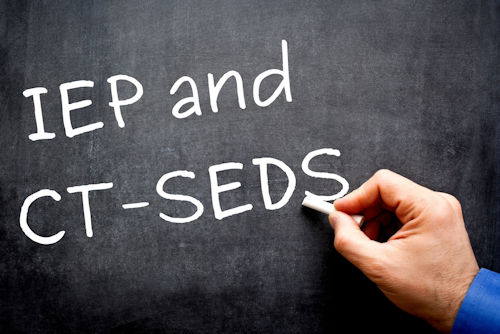Special Considerations (Detailed)
There are six questions requiring consideration for every student on the
Connecticut IEP form. Below you will see the questions as well as the issues
to consider for each question. The discussion and consideration of these
factors may lead to additional services or accommodations in the student’s IEP.
CT’s IEP uses the language of Special Considerations, however, in the
Individuals with Disabilities Education Act (IDEA),
the term “special factors” is used to describe the same areas of concern.
Does the student exhibit behaviors that impede learning of self or others?
- The PPT must consider positive behavioral interventions, strategies, and supports that address the student’s behavioral needs
- The PPT must identify the behavior(s) that interfere with the student’s learning or the learning of others
- The PPT must consider if a functional behavioral assessment (FBA) is needed to assess the given behavior. Identifying the behavior includes understanding the function or purpose of the behavior
- The PPT must consider developing IEP goals or adding accommodations to address the student’s behavioral needs
- The PPT must consider developing a Behavior Intervention Plan (BIP)
Is the student deaf or hard of hearing?
- The PPT must consider language and communication needs
- The PPT must consider opportunities for direct communication with peers and professional personnel in the student’s language and mode of communication
- The PPT must consider the student’s academic level
- The PPT must consider the full range of needs, including opportunities for direct instruction in the student’s language and communication mode
- CT requires documentation of these considerations in a Language and Communication Plan (LCP)
Is the student blind or visually impaired?
- This special factor is about teaching a student who is blind or visually impaired how to use Braille unless, through evaluation, it is determined that Braille is not appropriate for the student now or in the future
- The PPT should consider if the student requires accessible educational materials (AEM)
Does the student have limited English proficiency? (English Learner)
- The PPT will consider
the impact of limited English
skills on the student’s ability to make meaningful educational progress
*English Language Proficiency Assessment is required for all English learners grades K-12 - The PPT should consider the language used in evaluation or if a bilingual format is best
Does the student require Accessible Educational Materials (AEM)?
- Is printed text a barrier for the student?
- Does the student have difficulty using technology-based materials?
- Does the student need AT to access specialized formats of print-based and/or technology-based materials?
Does the student require an alternative mode of communication (such as Braille, sign language or Augmentative and Alternative Communication (AAC)?
- Can the student communicate appropriately and effectively, and if not, why not? How would the deficit in communication be described?
- Can the student effectively communicate across people and settings?
- Does the student need evaluation, services and/or assistive technology to communicate?
Every student’s communication needs must be considered, regardless of their disability.
The CT Special Education Data System (CT-SEDS)
has prompts in the system that require answers to questions about these special
factors when writing in the
IEP form.
While the need for
Assistive Technology (AT)
is one of the special factors in IDEA that requires teams to consider for
every student, regardless of their disability, CT’s IEP will list AT in the
section with
Supplementary Aids and Services.
»
Special Considerations (Comprehensive) PDF
»
Documento en espanol viene pronto
Helpful Videos
Best Practices: What are Accessible Educational Materials and How Can They Support My Child?
Best Practices: Augmentative and Alternative Communication (AAC) in Schools












